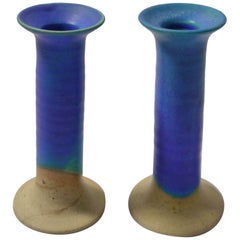Inger Krebs
Recent Sales
Late 20th Century Danish Scandinavian Modern Candlesticks
Ceramic
A Close Look at scandinavian-modern Furniture
Scandinavian modernism is perhaps the warmest and most organic iteration of modernist design. The work of the designers associated with vintage Scandinavian modern furniture was founded on centuries-old beliefs in both quality craftsmanship and the ideal that beauty should enhance even the humblest accessories of daily life.
ORIGINS OF SCANDINAVIAN MODERN FURNITURE DESIGN
- Emerged in the 1930s
- Originated primarily in Denmark, Sweden and Finland
- Introduced in the United States in mid-20th century
- Informed by the Bauhaus and modernism; influenced American mid-century modernism
CHARACTERISTICS OF SCANDINAVIAN MODERN FURNITURE DESIGN
- Bold, clean lines and simple, sturdy symmetries
- Use of natural materials — native woods such as pine, ash and beech
- Open, airy spaces
- Promotion of functionality
- Emphasis on craftsmanship; rooted in cabinetry profession and traditional construction techniques
- Minimal ornamentation (little to no embellishment)
- A neutral or light color palette owing to prominence of light woods
SCANDINAVIAN MODERN FURNITURE DESIGNERS TO KNOW
- Alvar Aalto
- Hans Wegner
- Kaare Klint
- Arne Jacobsen
- Greta Magnusson Grossman
- Finn Juhl
- Arne Vodder
- Verner Panton
ICONIC SCANDINAVIAN MODERN FURNITURE DESIGNS
VINTAGE SCANDINAVIAN MODERN FURNITURE ON 1STDIBS
The gentle, organic contours that are typical of Scandinavian design appear in the furnishings and decor created by Danish, Finnish and Swedish designers not as a stylistic gesture, but rather as a practical, ergonomic — and, as importantly, elegant — response to the human form.
Each nation produced exceptional talents in all areas of the applied arts, yet each had its forté. Sweden was home to Greta Magnusson Grossman and Bruno Mathsson — creators of the classic Grasshopper lighting series and Berlin daybed, respectively — but the country excelled most notably at ceramics. In the 1920s at the great Gustavsberg porcelain manufactory, Wilhelm Kåge introduced pieces in the Scandinavian style based on influences from folklore to Cubism; his skills were passed on to his versatile and inspired pupils Berndt Friberg and Stig Lindberg.
Likewise, Finland produced a truly ingenious Scandinavian modern furniture designer in the architect Alvar Aalto, a master at melding function and artistic form in works like the Paimio chair, created in collaboration with his first wife, Aino. Yet Finnish glassware was pre-eminent, crafted in expressive, sculptural designs by Tapio Wirkkala and Timo Sarpaneva.
The Danes excelled at chairs. Hans Wegner and Arne Jacobsen were exemplars of the country’s facility with wood, particularly teak.
Wegner created such iconic pieces as the Round chair and the Wishbone chair; Jacobsen — while the revolutionary architect and furniture innovator produced the best-selling plywood Ant chair — designed two classic upholstered pieces of the 1950s: the Swan chair and Egg chair. The list of great Danes could go on and on, including Finn Juhl, a stylistic maverick and maker of the bold Chieftain chair; Poul Kjaerholm, with his lean metal-and-rattan aesthetic; and Verner Panton, who introduced a vibrant Pop note into international design.
Today, decades after their heyday, the prolific, ever-evolving Scandinavian modernists continue to amaze and delight, and interior designers all over the world use their pieces to bring warmth to any given space.
On 1stDibs, you will note both instantly recognizable vintage Scandinavian modern chairs, sofas, rugs and tables — those that have earned iconic status over time — and many new discoveries.
Finding the Right candlesticks for You
Vintage, new and antique candlesticks and candleholders do not simply infuse a dining room with a soft, warm glow. They also add dimension, conjure drama and draw attention to a table or mantel. Despite their practical origins, today, decorative candlesticks and their holders elevate spaces by matching interiors or adding color and bold shapes.
For those who enjoy the rich pageantry of the Old Masters, candlesticks in the Baroque and Rococo styles offer intricacy and opulence. The design of Baroque candlesticks — thanks to the influence of the Catholic Church — often boasted complex shapes and featured biblical figures. While bronze candlestick holders have a long history dating back to the ancient world, many 17th-century candlesticks were made of luxurious silver. Armed with a disposable income and a desire to show off their status, the newly emerging middle class acquired candlestick holders as intricate art pieces, beautiful and opulent in their own right.
The Art Deco movement of the early 20th century saw candlesticks designed with simplicity and symmetry in mind. Art Deco candlesticks boast all manner of forms, ranging from sleek curves to bodies of ribbed crystal or bronze that take the shape of animals.
While some 20th-century-era candlesticks are akin to statues in their grandeur, these decorative items became especially fashionable in the mid-20th century for atmospherically illuminating dinner tables. Mid-century modern candlesticks frequently epitomize the streamlined functionality that we’ve come to associate with the era.
Find a comprehensive collection of vintage, new and antique candlesticks on 1stDibs.
